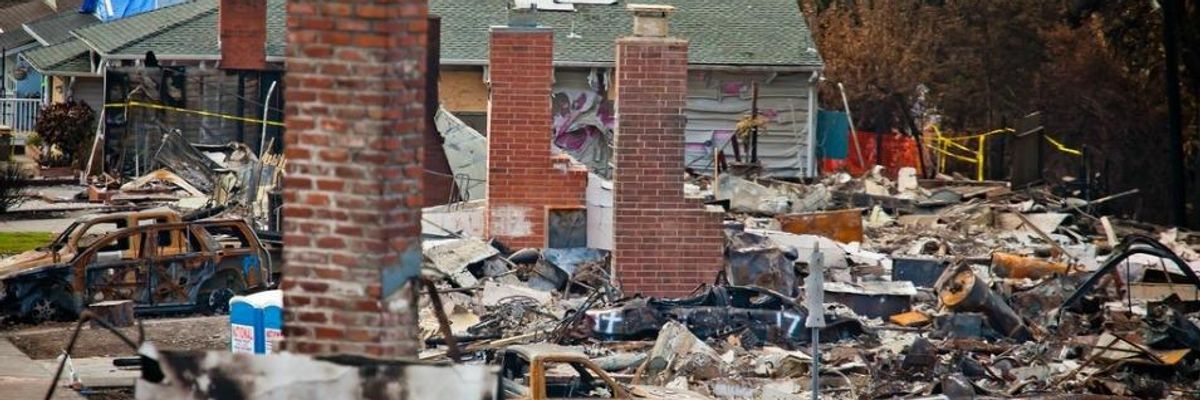

SUBSCRIBE TO OUR FREE NEWSLETTER
Daily news & progressive opinion—funded by the people, not the corporations—delivered straight to your inbox.
5
#000000
#FFFFFF
To donate by check, phone, or other method, see our More Ways to Give page.


Daily news & progressive opinion—funded by the people, not the corporations—delivered straight to your inbox.

The aftermath of the September 9, 2010 pipeline explosion in San Bruno, California, which killed nine people and destroyed 70 homes. (Photo: Thomas Hawk/cc/flickr)
A day after a pipeline exploded in West Virginia sending flames "hundreds of feet into the air," a new report by federal investigators is raising concern that lax oversight of gas transmission pipelines may increasingly threaten people's lives and property.
The study (pdf), issued Tuesday by the National Transportation Safety Board (NTSB), was released amid a growing push by the federal government to extract and exploit the vast gas holdings found in shale deposits around the U.S..
The report points to three recent pipeline explosions which prompted the investigation. In 2009, a pipeline explosion in Palm City, Florida sent 106 feet of buried pipeline into the air and released 36 million cubic feet of gas. A 2010 explosion in San Bruno, California killed nine people and destroyed 70 homes. And on December 11, 2012 a rupture in a pipeline that hadn't been inspected in 24 years destroyed three homes.
In each case, the report charges, gas companies failed to conduct inspections or tests that would have discovered problems before the explosions.
Since the NTSB issued regulations governing the integrity management of pipelines in 2004, the number pipeline accidents has "leveled off," the report finds. However, according to the study, the number of accidents involving "high consequence area pipelines," where people or buildings are more likely to be impacted, have increased in recent years.
There are currently 298,000 miles of onshore natural gas transmission pipelines in the U.S.. More than half of those lines were installed before 1970. Such lines, according to the board, have a significantly higher failure rate due to longer environmental exposure and lack of improved safety technology.
Following the investigation, the NTSB has issued 28 new recommendations to state and federal regulators. "Improving pipeline safety is a critical human safety issue that can and must be improved now," said NTSB acting chairman Christopher Hart in a press statement. "Effective oversight and management of these programs save lives, preserve property, and protect the environment."
Dear Common Dreams reader, The U.S. is on a fast track to authoritarianism like nothing I've ever seen. Meanwhile, corporate news outlets are utterly capitulating to Trump, twisting their coverage to avoid drawing his ire while lining up to stuff cash in his pockets. That's why I believe that Common Dreams is doing the best and most consequential reporting that we've ever done. Our small but mighty team is a progressive reporting powerhouse, covering the news every day that the corporate media never will. Our mission has always been simple: To inform. To inspire. And to ignite change for the common good. Now here's the key piece that I want all our readers to understand: None of this would be possible without your financial support. That's not just some fundraising cliche. It's the absolute and literal truth. We don't accept corporate advertising and never will. We don't have a paywall because we don't think people should be blocked from critical news based on their ability to pay. Everything we do is funded by the donations of readers like you. Will you donate now to help power the nonprofit, independent reporting of Common Dreams? Thank you for being a vital member of our community. Together, we can keep independent journalism alive when it’s needed most. - Craig Brown, Co-founder |
A day after a pipeline exploded in West Virginia sending flames "hundreds of feet into the air," a new report by federal investigators is raising concern that lax oversight of gas transmission pipelines may increasingly threaten people's lives and property.
The study (pdf), issued Tuesday by the National Transportation Safety Board (NTSB), was released amid a growing push by the federal government to extract and exploit the vast gas holdings found in shale deposits around the U.S..
The report points to three recent pipeline explosions which prompted the investigation. In 2009, a pipeline explosion in Palm City, Florida sent 106 feet of buried pipeline into the air and released 36 million cubic feet of gas. A 2010 explosion in San Bruno, California killed nine people and destroyed 70 homes. And on December 11, 2012 a rupture in a pipeline that hadn't been inspected in 24 years destroyed three homes.
In each case, the report charges, gas companies failed to conduct inspections or tests that would have discovered problems before the explosions.
Since the NTSB issued regulations governing the integrity management of pipelines in 2004, the number pipeline accidents has "leveled off," the report finds. However, according to the study, the number of accidents involving "high consequence area pipelines," where people or buildings are more likely to be impacted, have increased in recent years.
There are currently 298,000 miles of onshore natural gas transmission pipelines in the U.S.. More than half of those lines were installed before 1970. Such lines, according to the board, have a significantly higher failure rate due to longer environmental exposure and lack of improved safety technology.
Following the investigation, the NTSB has issued 28 new recommendations to state and federal regulators. "Improving pipeline safety is a critical human safety issue that can and must be improved now," said NTSB acting chairman Christopher Hart in a press statement. "Effective oversight and management of these programs save lives, preserve property, and protect the environment."
A day after a pipeline exploded in West Virginia sending flames "hundreds of feet into the air," a new report by federal investigators is raising concern that lax oversight of gas transmission pipelines may increasingly threaten people's lives and property.
The study (pdf), issued Tuesday by the National Transportation Safety Board (NTSB), was released amid a growing push by the federal government to extract and exploit the vast gas holdings found in shale deposits around the U.S..
The report points to three recent pipeline explosions which prompted the investigation. In 2009, a pipeline explosion in Palm City, Florida sent 106 feet of buried pipeline into the air and released 36 million cubic feet of gas. A 2010 explosion in San Bruno, California killed nine people and destroyed 70 homes. And on December 11, 2012 a rupture in a pipeline that hadn't been inspected in 24 years destroyed three homes.
In each case, the report charges, gas companies failed to conduct inspections or tests that would have discovered problems before the explosions.
Since the NTSB issued regulations governing the integrity management of pipelines in 2004, the number pipeline accidents has "leveled off," the report finds. However, according to the study, the number of accidents involving "high consequence area pipelines," where people or buildings are more likely to be impacted, have increased in recent years.
There are currently 298,000 miles of onshore natural gas transmission pipelines in the U.S.. More than half of those lines were installed before 1970. Such lines, according to the board, have a significantly higher failure rate due to longer environmental exposure and lack of improved safety technology.
Following the investigation, the NTSB has issued 28 new recommendations to state and federal regulators. "Improving pipeline safety is a critical human safety issue that can and must be improved now," said NTSB acting chairman Christopher Hart in a press statement. "Effective oversight and management of these programs save lives, preserve property, and protect the environment."